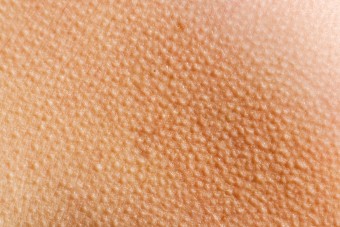What Are Goose Bumps?
 A holdover from an earlier stage in our evolution, goose bumps are a function of the autonomic nervous system reacting to a primal threat.
A holdover from an earlier stage in our evolution, goose bumps are a function of the autonomic nervous system reacting to a primal threat.
Technically, the phenomenon is called the pilomotor reflex, and occurs when the arrector pili muscle, which runs between the base of a hair follicle and the outer layer of skin, contracts.
In the absence of cold or danger, the hair extending from the follicle comes out at a shallow angle, such that it rests (or nearly so) against the skin. When stress is encountered (either cold temperatures, a threat, or a time where your emotions are going a little haywire, such as when walking down the aisle during your wedding), messages are sent through the nervous system to nerve endings that trigger the arrector pili muscles. These in turn contract, pulling the bulb of the hair follicle toward it, and the adjacent outer layer of skin; this results not only in the characteristic bump on the surface of the skin, bu t causes the hair to stand on end.
t causes the hair to stand on end.
Note how, for an animal living a more primitive existence than the modern human, this would be a benefit. As the hair stands on end, if as a result of cold, it provides more insulation to the body below by trapping a thicker layer of air between your skin and the elements – ameliorating the problem. Likewise, if the hair stands on end as the result of a threat, the puffed up hair makes the animal appear larger and more threatening, and thus helps ward off potential attackers.
Of course, a variety of animals experience this involuntary reaction, and for those of us who own a tom cat who lives outside, it’s not uncommon to see them become remarkably bushy if stuck out there in the cold rain or when faced with an aggressive foe.
Obviously, humans no longer need this reaction as our clothing and weapons satisfy these needs, and we really don’t have all that much hair anymore to make this physiological response useful… well, most of us, anyway; as such, at least for these purposes, goose bumps are considered a vestigial trait.
And if you’re curious as to why this physiological response is called by this particular name, the word, goosebumps, dates back to 1859 and was coined due to the similarity between human skin in the midst of an attack and that of the skin of a freshly plucked goose. Earlier iterations of this same idea were known as goose-flesh from the early 1800s and goose-skin or goose’s skin from the late 1700s.
If you liked this article, you might also enjoy our new popular podcast, The BrainFood Show (iTunes, Spotify, Google Play Music, Feed), as well as:
- What Causes Warts?
- What Causes Dark Circles Under Your Eyes?
- What Causes Canker Sores?
- The Roller Coaster Designed to Kill Its Passengers
- Why Do Fingernails on a Chalkboard or Scraping on a Plate Make Us Cringe?
Bonus Facts:
- Goose flesh is used to describe the pilomotor reflex in more languages than just English. In German, it’s Gänsehaut, Italian its pelle d’oca, Swedish, gâshud, Polish, gęsia skórka, Norwegian, gâsehud, Latvian, zosãda and Slovak, husia koža. Still other languages describe the phenomenon in reference to different poultry including chicken skin in Chinese, Dutch (kippenvel), Korean, and Finnish (kananliha), and more particularly, “hen” in French (chair de poule), Spanish (piel de gallina) and Romanian (piele de gaina).
- Canada geese can grow to a wingspan of nearly 6 feet and can live for more than 20 years. Highly adaptable, they are found everywhere from wild habitats to suburban ponds and even urban parks. As such, in some places they have become a nuisance to the point that officials felt the need to slaughter the animals. For example, in 2010, hundreds of geese were killed in Brooklyn’s Prospect Park in an effort to ameliorate their flying into jet engines.
- Most migratory geese will migrate at altitudes of many thousands of feet, but the real king of them all is the Bar-Headed goose, which has been observed flying as high as 30,000 feet (9144 meters) as the birds migrate over the Himalayas. Another super-high flyer is Whooper Swans, which have been observed flying as high as 29,000 feet (8839 meters).
- So those are the highest flying birds, what are the fastest? That record belongs to the White-throated Needletail which is capable of flying in a straight path as fast as 105 mph (170 km/h). The fastest diving bird is the Peregrine Falcon, which has been recorded diving at speeds up to 200 mph (322 km/h).
- Many people often misuse the word “gaggle” thinking it refers to a group of geese in general. In fact, it technically just means a group of geese on the ground. When they are in the air, they are called a “skein”, when flying in a V, or a “plump”, when flying in a close-knit group.
- During the nesting season, the adult geese lose the ability to fly as they molt and drop their wing feathers. This coincides with the baby geese, called goslings, maturing to the point where they can fly (which takes 2-3 months). This is also why geese so frequently choose to put their nests near a body of water; so they can still get away from many predators during the time period they can’t fly. Around 6 weeks after molting, the adults can once again soar the sky.
- Migrating geese often fly as much as 2000-3000 miles before their journey is done. In the extreme with a very favorable wind and at high altitude, they can actually travel as much as 1500 miles in a 24 hour period, but generally migrate in a much more leisurely fashion, traveling slowly and taking frequent stops at certain seemingly designated areas.
- Geese have been around on the Earth for approximately 10 million years.
- Canada geese enjoy a wide variety of food including grasses, seeds, berries and sometimes even small fish and mollusks. As such, their meat is delicious, if greasy, and perhaps this latter explains why goose has gone out of fashion at Christmas feasts.
- To cook a goose, after it is defrosted (or if fresh) let it set outside of the refrigerator for 30-60 minutes in order for it to come to room temperature. Martha Stewart recommends roasting it in a 400F oven after first rinsing it, patting it dry and removing as much fat as possible from the cavity opening. After an hour, remove the bird from the oven, then siphon most of the melted fat from the pan, then return the goose to a lower oven (325F) until it is browned and reaches a temperature of 180F.
- Goose fat is prized for cooking and chefs recommend you save the trimmed bits and melt it down. Then, along with the melted goose fat siphoned from the roasting pan, strain it, let it cool and store it in the refrigerator for up to 6 months. Solid when cold, the fat can then be used like butter to flavor vegetables, meats and any savory dish that needs a bit of oil.
| Share the Knowledge! |
|





I learned that goose bumps was because of your nervous system and your skin pulled tight…..it would like sort of strech….right?
right!!!!!!!!!!!!!!!!!